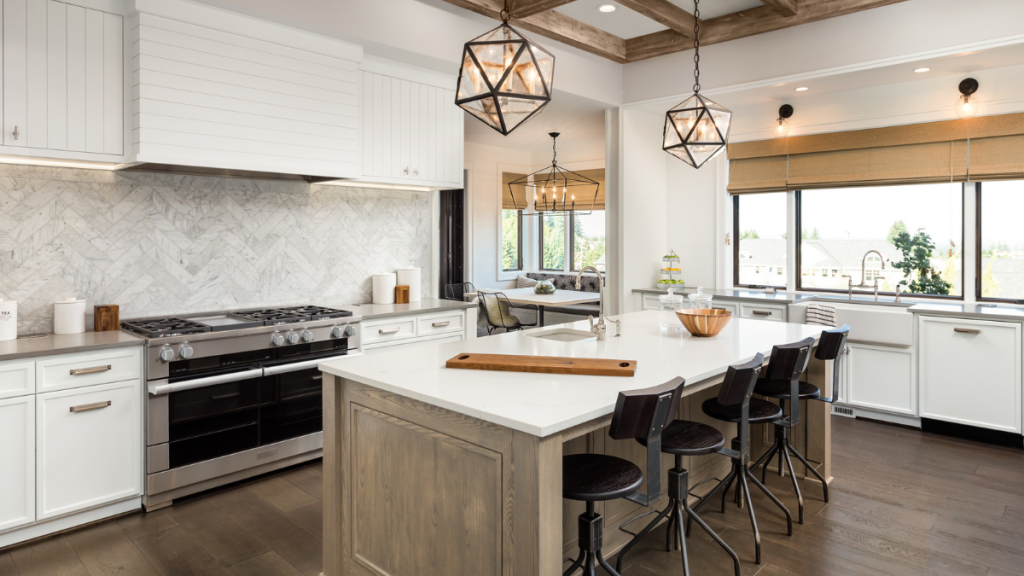By Maura Keller
Flooring is an essential component to every home and is quite literally the foundation of every room’s aesthetic. From rich, exotic hardwoods to pre-engineered luxury plank to stunning handmade tile or porcelain, flooring is crucial to tying together a home’s overall look.
When choosing flooring, think about its function and location in your home, your lifestyle and its durability.
“With the variety of different types of flooring available today, it can get quite overwhelming,” says Linda Kreye, head of sales and design at Four Seasons Flooring in Delavan. “There’s only one rule you must keep in mind when choosing flooring, and that is flexibility. Each type is excellent depending on the intended occupants of a house, a room’s function, your budget and so on.”
Dianne Fasano, owner at Bella Tile & Stone in Lake Geneva, says when selecting tile or stone in the home, it’s key for homeowners to think about their design aesthetic and where the flooring will be used in the home. This is especially important in areas that have moisture — such as spaces that guests use to enter a home after water activities.
“Also, maintenance is another factor people should consider. Natural stone is very beautiful, but does require resealing every few years based on amount of use,” Fasano says. “Whereas tile or porcelains are basically maintenance free.”
Here’s a quick and easy explainer on kinds of flooring, what to consider when making your flooring decisions and how each type can be ideal for different areas in your home.
Carpet
Pros: Carpet is fairly inexpensive. Compared to other flooring types, carpeting tends to be cheaper. It’s
also quieter, softer, versatile, hides dirt in most cases, and it’s easier and faster to install.
Cons: Carpet will show wear and tear and does require maintenance, including frequent vacuuming and cleaning once or twice a year. Carpet isn’t ideal for areas with a lot of moisture or outdoor activity.
Hardwood
Pros: Hard and heavy, there is nothing quite like natural wood flooring. With stylish grain patterns and unique species in a variety of hues, wood flooring provides beauty and charm underfoot. Also, hardwood comes in various widths, can be fine milled or hand scraped.
Hardwood floors also provide a neutral background that allows for a multitude of designs, thanks to the variety of species available. It can be easy to maintain.
Cons: Hardwoods can be expensive, susceptible to moisture damage and can be easily scratched. They also typically need to be refinished over time. And, areas that have heavy, daily sun exposure may experience fading or lightening.
Vinyl
Pros: Vinyl flooring has come a long way in the last several years. It is relatively indestructible while also being resistant to moisture.
“It is the easiest of the floor options to install and is usually the most inexpensive,” Fasano says. “When selecting vinyl flooring, it is important to look at the wear level. Vinyl flooring can range in wear from 12 mil to 20 mil. The higher the wear number, the more durable the vinyl will be over time.”
Vinyl flooring is durable, easy to install, requires little maintenance, has an attractive look and is water-resistant.
Cons: Vinyl can be damaged more easily than some other types of flooring. Also, fading may occur with direct sunlight. This material is also not biodegradable.
Laminate
Pros: Laminate is made from pressed wood. It’s more durable and resists scratches, moisture, and wear and tear. This type of flooring is also easier to clean.
Cons: Even though laminate is more durable, it is not as visually appealing. The lower qualities of laminate may have artificial-looking wood grain textures.
Ceramic and Porcelain Tile
Pros: Ceramic and porcelain tile are probably the most interesting and creative of the flooring types. Some options include natural stone, cement, terra cotta and an array of porcelains.
“In the last 10 years, tile options have changed dramatically,” says Fasano. “We are seeing far more color and shapes of all tiles with brighter colors being an absolute trend in 2023.”
Tile flooring is strong and has a beautiful appearance. It is resistant to moisture and stains, bacteria and allergies, abrasion and extreme heat. It’s also easy to clean. Tile is available in a staggering variety of shapes, patterns, sizes and colors. Tile can also be installed practically anywhere in the home.
Cons: Tile can be expensive compared to other types of flooring. The grout between tiles needs to be actively maintained, especially in high-traffic areas. Staining, crumbling and mold are all issues to look out for.
“Tile is also infamous for cooling down during the winter months,” Kreye says. “Installing radiant heating is a game-changer if you want to keep your tile floors warm underfoot. However, radiant heating can be a pricey add-on — but well worth the investment.”
Luxury Vinyl Plank
Pros: Luxury vinyl plank flooring is durable and is scuff- and dent- resistant. It’s also a cost-effective way to bring style in your space.
This material is sometimes cheaper than traditional hardwood, and can offer a similar look. Luxury vinyl plank has near-infinite options for looks mimicking materials like wood, stone and color palettes to match any décor.
Cons: If your room has a lot of natural lighting, this can lead to fading in spots over time. Luxury vinyl plank cannot be refinished.
